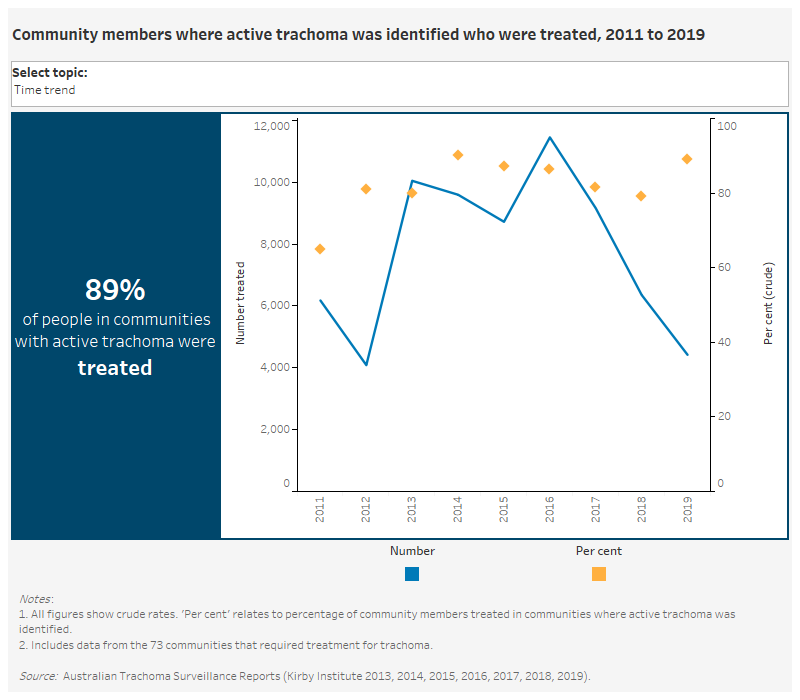Trachoma and trichiasis treatment coverage
Measures 3.8.1 and 3.8.2: The estimated number, and proportion of:
- Community members who were treated in communities where active trachoma was identified
- Indigenous adults with trichiasis who were treated.
The screening and treatment frequency for trachoma in at-risk communities is based on the trachoma prevalence rate. Treatment for trichiasis is important for preventing vision loss.
There are 3 separate charts for this measure by various characteristics.
Community members where active trachoma was identified who were treated by age, 2019
This dual axis combined vertical bar chart and scatter plot displays the number and percentage of active trachoma cases treated in 2017, by age. The chart shows that a total of 4,419 Indigenous Australians with active trachoma received treatment for the condition, a rate of 89%. This included 492 children aged 0–4 (91%), 593 aged 5–9 (97%) and 515 aged 10–14 (94%) and 2,819 Indigenous young Australians and adults aged 15 years and over (86%).
Community members where active trachoma was identified who were treated 2011 to 2019
This dual axis combined line chart and scatter plot shows the percentage and number of active trachoma cases treated between 2011 and 2019. The chart shows that, in this period, the proportion of Indigenous Australians with active trachoma who received treatment rose from 65% to 89%, peaking at 90% in 2014. The number of Indigenous Australians requiring treatment for trachoma fell from 6,175 to 4,419 over the same period.
Community members where active trachoma was identified who were treated by jurisdiction, 2019
This dual axis combined vertical bar chart and scatter plot displays the percentage and number of active trachoma cases treated in 2019, by jurisdiction. The chart shows that the proportion of Indigenous Australians with active trachoma who received treatment was 100% in Queensland (25 people), 98% in Western Australia (890 people), 100% in South Australia (35 people), and 87% in the Northern Territory (3,472 people).

- In 2019, in communities where active trachoma was identified, a total of 4,419 community members received treatment, a rate of 89%. This included 492 children aged 0–4 (91%), 593 aged 5–9 (97%), 515 aged 10–14 (94%) and 2,819 (86%) community members aged 15 and over.
- Between 2011 and 2019, in communities where active trachoma was identified, the proportion of community members who received treatment rose from 65% in 2011 to 90% in 2014, declined to 79% in 2018 and then rose again to 89% in 2019.
- In 2019, in the 4 jurisdictions with at-risk communities, 6 of the 9 (67%) Indigenous adults aged 40 and over with trichiasis had surgery in the past 12 months. Four of the 6 surgeries took place in the Northern Territory.
- Between 2012 and 2019, the number of Indigenous adults aged 40 and over who had surgery for trichiasis rose from 16 adults in 2012 to 31 in 2013. The number of surgeries has generally declined over time since then, to 6 in 2019.


